Immigrant voters face unique challenges related to citizenship status, language barriers, and the need for community support. Understanding the naturalization process and accessing legal resources are essential for those aiming to participate in democracy. Additionally, language assistance programs and community organizations play a vital role in helping immigrants navigate the voting process, fostering greater engagement and empowerment within their communities.
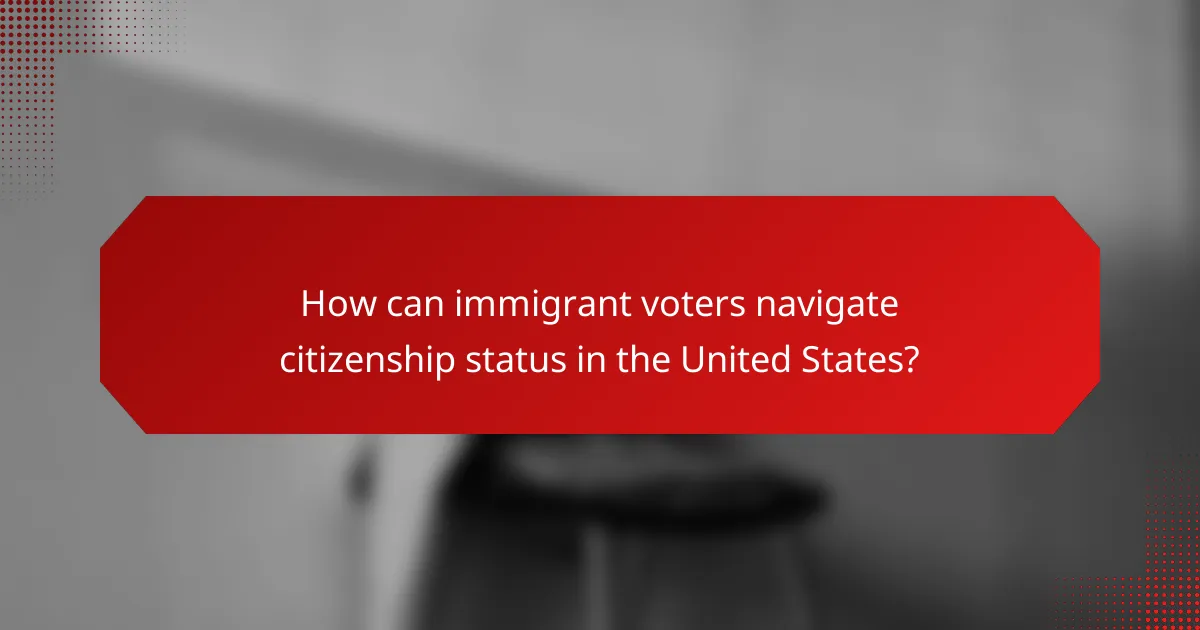
How can immigrant voters navigate citizenship status in the United States?
Immigrant voters can navigate their citizenship status by understanding the naturalization process, knowing eligibility requirements, and accessing legal resources. These steps are crucial for those seeking to participate fully in the democratic process.
Understanding the naturalization process
The naturalization process allows immigrants to become U.S. citizens after fulfilling specific criteria. It typically involves submitting an application, attending an interview, and passing a citizenship test that assesses knowledge of U.S. history and government.
Applicants should be prepared for the process to take several months, depending on the local U.S. Citizenship and Immigration Services (USCIS) office’s workload. Staying organized and following up on application status can help ensure a smoother experience.
Eligibility requirements for citizenship
To be eligible for U.S. citizenship, applicants generally must be at least 18 years old, have lawful permanent resident status for a minimum of five years, and demonstrate good moral character. Additional requirements include proficiency in English and knowledge of U.S. civics.
Some exceptions exist, such as for spouses of U.S. citizens, who may apply after three years of residency. Understanding these nuances can help immigrants better prepare for their citizenship journey.
Resources for legal assistance
Numerous organizations provide legal assistance to immigrants navigating the citizenship process. Nonprofits like the American Immigration Lawyers Association (AILA) and local community organizations often offer free or low-cost services.
It is advisable for applicants to seek help from reputable sources to avoid scams. Many legal aid organizations can assist with application preparation, interview preparation, and understanding rights as a voter.
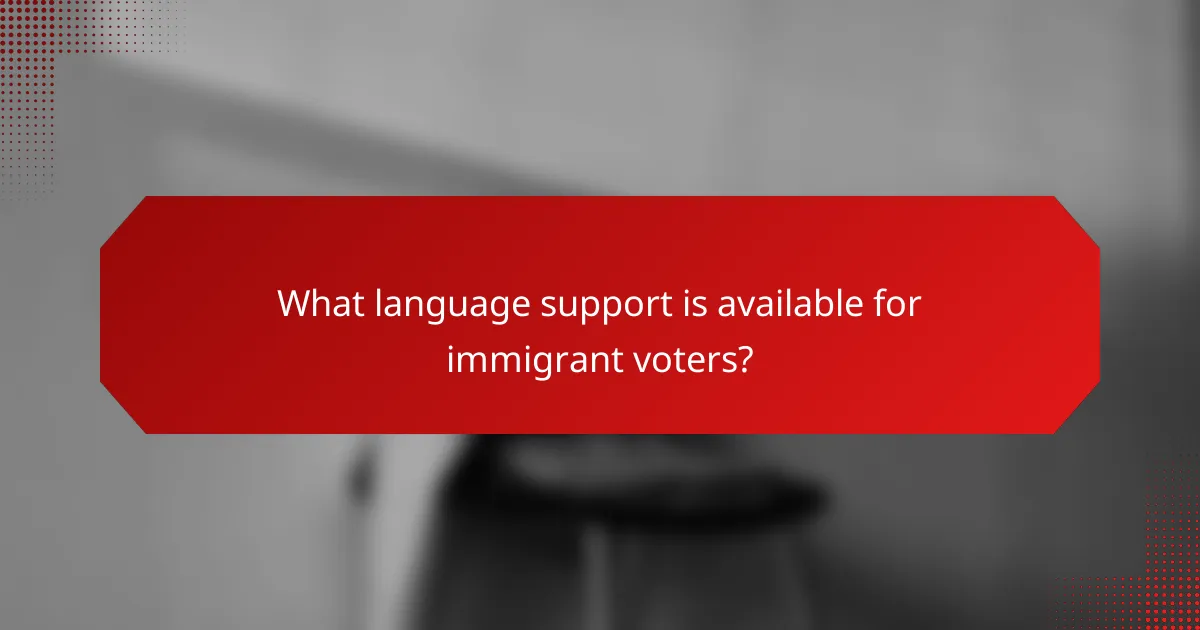
What language support is available for immigrant voters?
Immigrant voters can access various language support services to help them navigate the voting process. These resources include language assistance programs, translated voting materials, and community organizations that offer translation services.
Language assistance programs in major cities
Many major cities provide language assistance programs designed to help immigrant voters understand the voting process. For example, cities like Los Angeles and New York City offer bilingual assistance at polling places, ensuring that voters can communicate effectively with election officials.
These programs often include trained interpreters who can assist voters in their preferred language, making the voting experience more accessible. It’s advisable for voters to check with their local election office to find out what specific language services are available in their area.
Voting materials in multiple languages
Voting materials, such as ballots and informational pamphlets, are often available in multiple languages to accommodate diverse populations. The U.S. Election Assistance Commission mandates that jurisdictions with significant language minority populations provide translated materials.
For instance, ballots in areas with large Spanish-speaking communities may be printed in both English and Spanish. Voters should verify with their local election office to ensure they receive materials in their preferred language.
Community organizations offering translation services
Numerous community organizations provide translation services to assist immigrant voters. These organizations often offer workshops and resources to educate voters about their rights and the voting process in their native languages.
Examples include local immigrant advocacy groups and non-profits that specialize in civic engagement. Engaging with these organizations can help voters access crucial information and support, ensuring they can participate fully in elections.
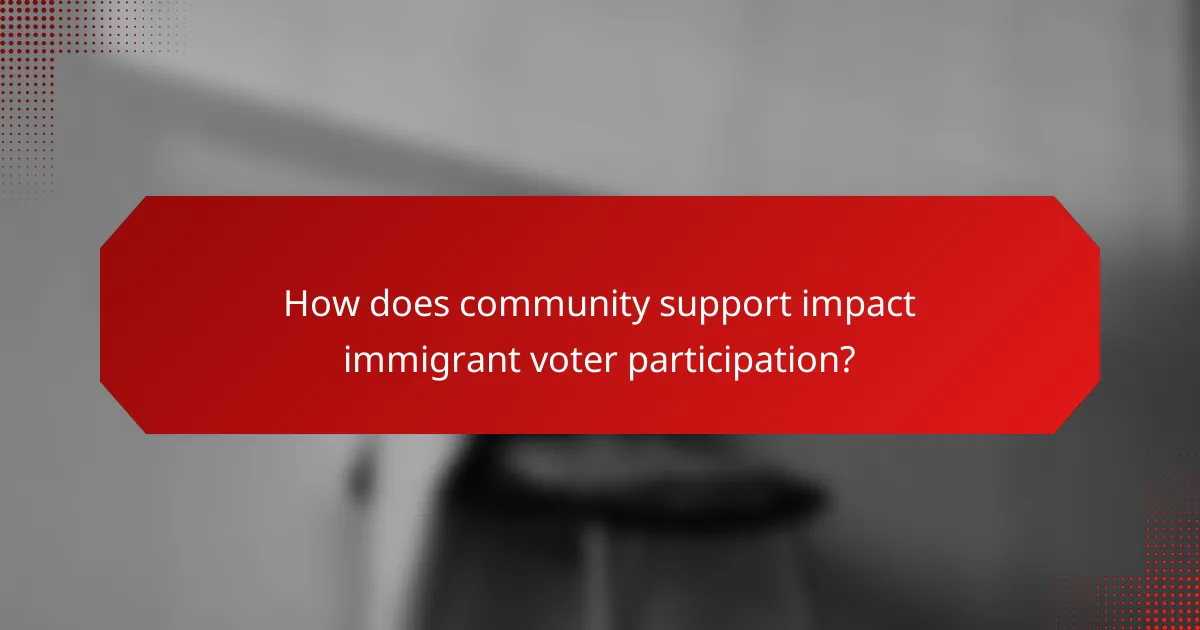
How does community support impact immigrant voter participation?
Community support plays a crucial role in enhancing immigrant voter participation by providing resources, information, and encouragement. When immigrants feel supported by their communities, they are more likely to engage in the voting process and exercise their rights.
Role of local advocacy groups
Local advocacy groups serve as vital resources for immigrant voters by offering education on voting rights and processes. These organizations often provide language assistance, helping to bridge communication gaps that may hinder participation.
Additionally, advocacy groups can mobilize community members through outreach efforts, ensuring that immigrants are aware of upcoming elections and the importance of their votes. Their presence can foster a sense of belonging and empowerment among immigrant populations.
Impact of community events on voter turnout
Community events, such as cultural festivals or town hall meetings, can significantly boost voter turnout among immigrants. These gatherings create opportunities for social interaction and information sharing, making the voting process feel more accessible and less intimidating.
Moreover, when events include voter registration drives or informational sessions, they can directly facilitate participation. Engaging activities that resonate with the community’s culture can motivate individuals to take action and vote.
Case studies of successful community initiatives
One notable case study is a city in California where a coalition of local organizations launched a “Get Out the Vote” campaign targeting immigrant neighborhoods. They utilized multilingual materials and door-to-door canvassing, resulting in a significant increase in voter registration and turnout.
Another example is a program in New York that integrated voter education into community health fairs. By combining health services with information on voting, they successfully reached a diverse audience, leading to higher engagement levels in local elections.
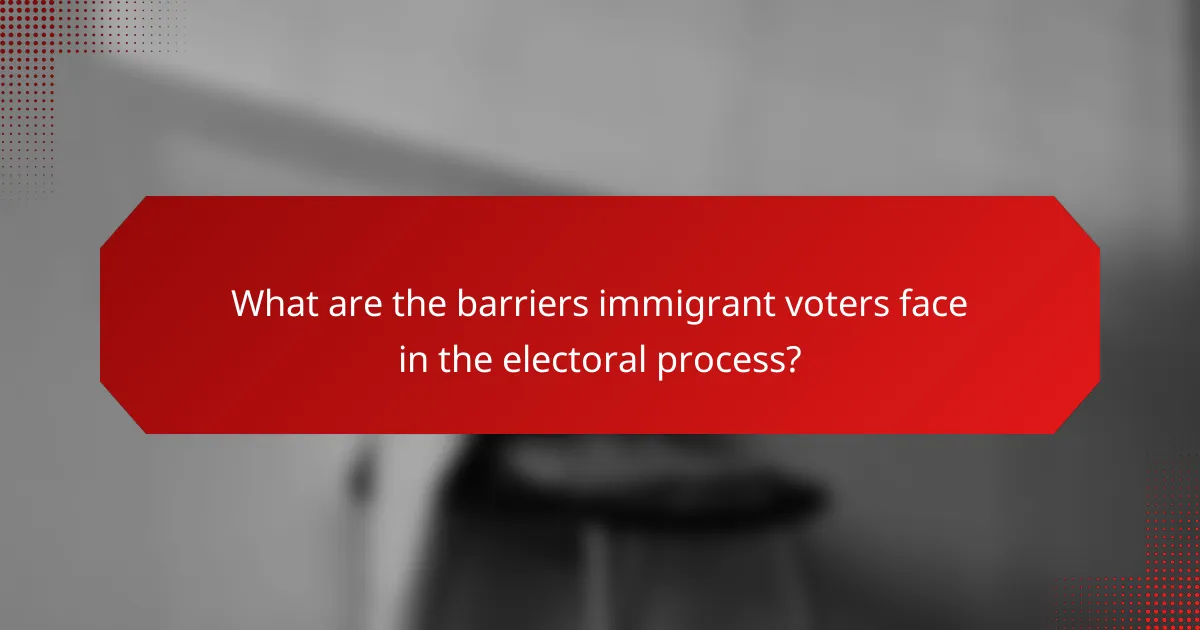
What are the barriers immigrant voters face in the electoral process?
Immigrant voters encounter several barriers in the electoral process, including issues related to citizenship status, language barriers, and limited community support. These obstacles can significantly hinder their ability to participate fully in elections.
Common challenges related to documentation
One of the primary challenges for immigrant voters is obtaining the necessary documentation to register and vote. Many immigrants may not have access to the required identification or may face difficulties in proving their citizenship status, especially if they are recent arrivals or lack proper legal documentation.
Additionally, varying state laws regarding voter ID requirements can complicate the process. Some states may require specific forms of identification that are not readily available to all immigrants, further limiting their ability to participate in elections.
Social and economic factors affecting participation
Social and economic factors play a crucial role in the participation of immigrant voters. Many immigrants face economic challenges that can limit their ability to take time off work to vote or to navigate the voting process. This is particularly true for those in low-wage jobs or those who work multiple jobs.
Language barriers can also hinder participation, as many immigrant voters may not be fluent in the dominant language used in their voting district. This can lead to misunderstandings about the voting process, candidates, and issues at stake, making it difficult for them to make informed decisions.
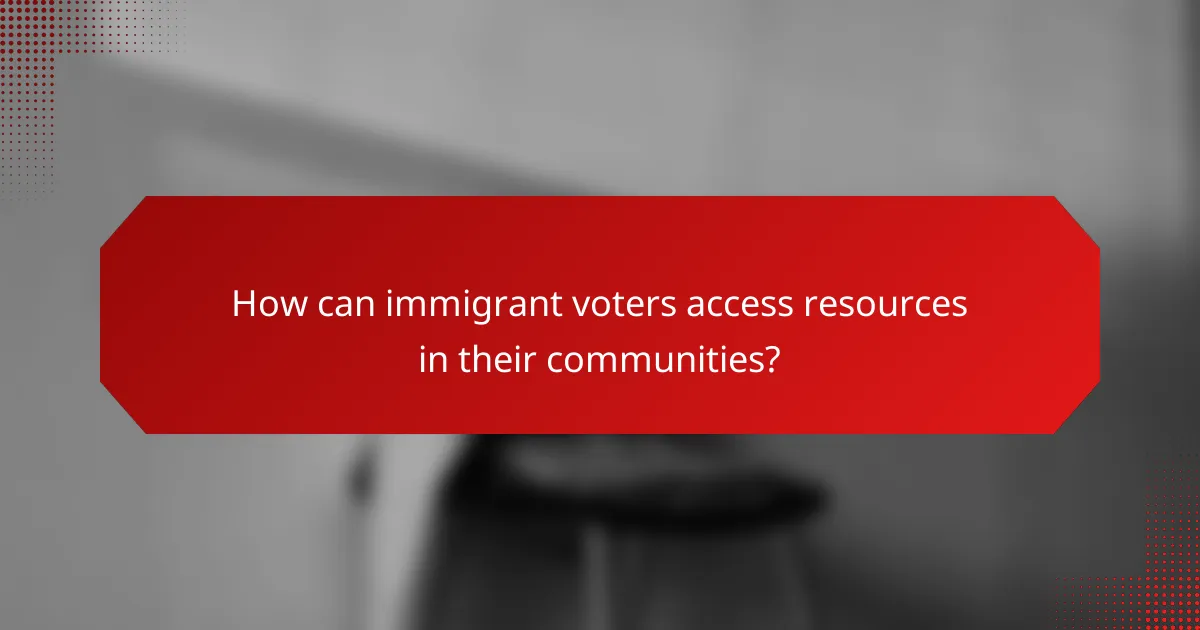
How can immigrant voters access resources in their communities?
Immigrant voters can access various resources in their communities through local government initiatives and nonprofit organizations. These resources often focus on voter education, language assistance, and community support to help navigate the voting process.
Local government resources for voter education
Local governments typically provide voter education resources tailored to the needs of immigrant communities. This may include multilingual materials, workshops, and informational sessions about the voting process, deadlines, and requirements.
Many municipalities offer online portals where voters can find information in their preferred language. Checking your local election office’s website is a good first step to access these resources.
Nonprofit organizations providing support
Numerous nonprofit organizations focus on assisting immigrant voters by offering services such as language translation, legal advice, and community outreach programs. These organizations often host events to educate voters about their rights and the voting process.
Examples of such organizations include the League of Women Voters and local immigrant advocacy groups. Engaging with these nonprofits can provide valuable support and guidance, especially for those facing language barriers or unfamiliarity with the electoral system.

What are the emerging trends in immigrant voter engagement?
Emerging trends in immigrant voter engagement highlight the increasing importance of technology, multilingual initiatives, and demographic shifts. These factors significantly influence how immigrant communities participate in elections and advocate for their rights.
Impact of technology on voter outreach
Technology plays a crucial role in enhancing voter outreach among immigrant populations. Digital platforms facilitate access to information about voting processes, candidate platforms, and registration requirements, often in multiple languages.
Social media campaigns and mobile applications are effective tools for engaging younger voters and those with limited English proficiency. Organizations can leverage these technologies to create targeted messaging that resonates with diverse communities.
Future of multilingual voting initiatives
Multilingual voting initiatives are becoming increasingly vital as the electorate diversifies. Offering ballots and voting materials in various languages helps ensure that non-English speakers can participate fully in the electoral process.
Future initiatives may include expanded language options and improved accessibility, such as in-person assistance and translation services at polling places. These efforts aim to reduce language barriers and empower immigrant voters.
Changing demographics and their influence on elections
Changing demographics significantly impact election outcomes, as immigrant communities grow in size and political influence. As these populations become more engaged, their voting patterns can sway local and national elections.
Understanding the unique concerns and priorities of different immigrant groups is essential for candidates and political parties. Tailoring campaigns to address issues such as immigration reform, economic opportunity, and social justice can enhance voter turnout among these communities.
